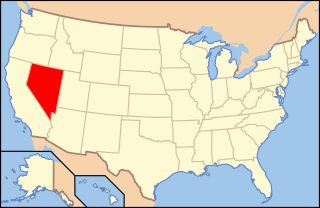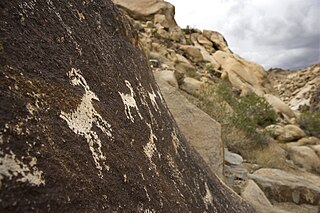
Mylodon is an extinct genus of ground sloths that lived in South America; Patagonia until roughly 5,000 years ago and was possibly the last ever ground sloth species to go extinct.

Yucca brevifolia is a plant species belonging to the genus Yucca. It is tree-like in habit, which is reflected in its common names: Joshua tree, yucca palm, tree yucca, and palm tree yucca.

Mylodontidae is a family of extinct mammals within the order of Pilosa and suborder Folivora living from around 23 million years ago (Mya) to 11,000 years ago, existing for roughly 23 million years. This family of ground sloths is related to the other families of extinct ground sloths, Megatheriidae and Nothrotheriidae. The only extant families of the suborder Folivora are Bradypodidae and Megalonychidae. Phylogenetic analyses using homologous sequences from all extant xenarthran groups indicate that the Mylodontidae were more closely related to the Megalonychidae than to the Bradypodidae.

Megalonyx is an extinct genus of ground sloths of the family Megalonychidae, which was endemic to North America from the Hemphillian of the Late Miocene through to the Rancholabrean of the Pleistocene, living from ~10.3 Mya—11,000 years ago, existing for approximately 10.289 million years. The type species, M. jeffersonii, measured about 3 meters (9.8 ft) and weighed up to 1,000 kilograms (2,200 lb).

Cueva del Milodón Natural Monument is a Natural Monument located in the Chilean Patagonia, 24 km (15 mi) northwest of Puerto Natales and 270 km (168 mi) north of Punta Arenas.

Corn Creek Campsite is located in the Desert National Wildlife Range and was used from around 1900–1924 for ranching and is listed on the United States National Register of Historic Places. Nearby is Mormon Well Spring another listed historic place.
Acratocnus is an extinct genus of ground sloth found in Cuba, Hispaniola and Puerto Rico.

Nothrotheriops is a genus of Pleistocene ground sloth found in North America, from what is now central Mexico to the southern United States. This genus of bear-sized xenarthran was related to the much larger, and far more famous Megatherium, although it has recently been placed in a different family, Nothrotheriidae. The most well known species, N. shastensis, is also called the Shasta ground sloth.
Shelter Cave is an archaeological and paleontological site located in Doña Ana County, New Mexico.

Nothrotherium is an extinct genus of medium-sized ground sloth from South America. It differs from Nothrotheriops in smaller size and differences in skull and hind leg bones, but both genera can be traced back to Hapalops, the genus which both evolved from in different ecological conditions. This genus formerly included the species Nothrotheriops shastensis, which was later moved to Nothrotheriops. These browsing ground sloths consumed roots, stems, seeds, and leaves of various desert plants, such as the yucca and agave.

Yucca Flat is a closed desert drainage basin, one of four major nuclear test regions within the Nevada Test Site (NTS), and is divided into nine test sections: Areas 1 through 4 and 6 through 10. Yucca Flat is located at the eastern edge of NTS, about ten miles (16 km) north of Frenchman Flat, and 65 miles (105 km) from Las Vegas, Nevada. Yucca Flat was the site for 739 nuclear tests – nearly four of every five tests carried out at the NTS.
Tule Springs Archaeological Site is an archeological site listed on the National Register of Historic Places that is located in the Las Vegas Valley of Nevada, United States. It is one of a few sites in the United States where humans were once thought to have lived alongside, and potentially hunted, extinct Ice Age megafauna, although this view is not supported by the available scientific data and is no longer generally accepted.

Harrington's mountain goat was a species of North American caprine that resided in the Southwest of the continent during the Pleistocene epoch. A relative of the modern mountain goat, which is the only existing species in the genus Oreamnos, O. harringtoni became extinct around 11,000 B.C.

Paleontology in Nevada refers to paleontological research occurring within or conducted by people from the U.S. state of Nevada. Nevada has a rich fossil record of plants as well as both invertebrate and vertebrate animal life. During the Late Precambrian eastern and southern Nevada was being gradually covered by a shallow sea that was home to blue-green bacteria. During the early Paleozoic a variety of local aquatic invertebrates inhabited both freshwater (molluscs) and salt water (graptolites). By the Carboniferous reefs formed despite a drop in local sea levels and a variety of plants flourished on land.

Nothrotheriidae is a family of extinct ground sloths that lived from approximately 11.6 mya—11,000 years ago, existing for approximately 11.49 million years. The nothrotheres have recently been moved from the tribe Nothrotheriini or subfamily Nothrotheriinae within Megatheriidae to their own family, Nothrotheriidae. Nothrotheriids appeared in the Tortonian, some 11.6 million years ago, in South America. The group includes the comparatively slightly built Nothrotheriops, which reached a length of about 2.75 metres (9.0 ft). While nothrotheriids were small compared to some of their megatheriid relatives, their claws provided an effective defense against predators, like those of larger anteaters today.

The Bridge Canyon Wilderness is a small wilderness area located in the Newberry Mountains in southern Nevada, United States. The rock outcrops and caves make this area very striking. Stands of cottonwood trees can be found along the Grapevine Wash and Sacatone Wash water courses. Canyon grape, cattails and rushes grow in Grapevine Canyon. Discover the petroglyphs of early Native Americans in the canyon. Reptiles include the Western chuckwalla, side-blotched lizard, and Gila monster.

Bechan Cave is a single-room sandstone rock shelter located at an elevation of 1,280 metres (4,200 ft) along Bowns Canyon Creek, a tributary of the Glen Canyon segment of the Colorado River, in Kane County in southeastern Utah in the United States. The cave is roughly 31 metres (100 ft) wide, 9 metres (30 ft) high and 52 metres (170 ft) deep. It has a single entrance that faces southwest and is well-lit during the daytime.






















